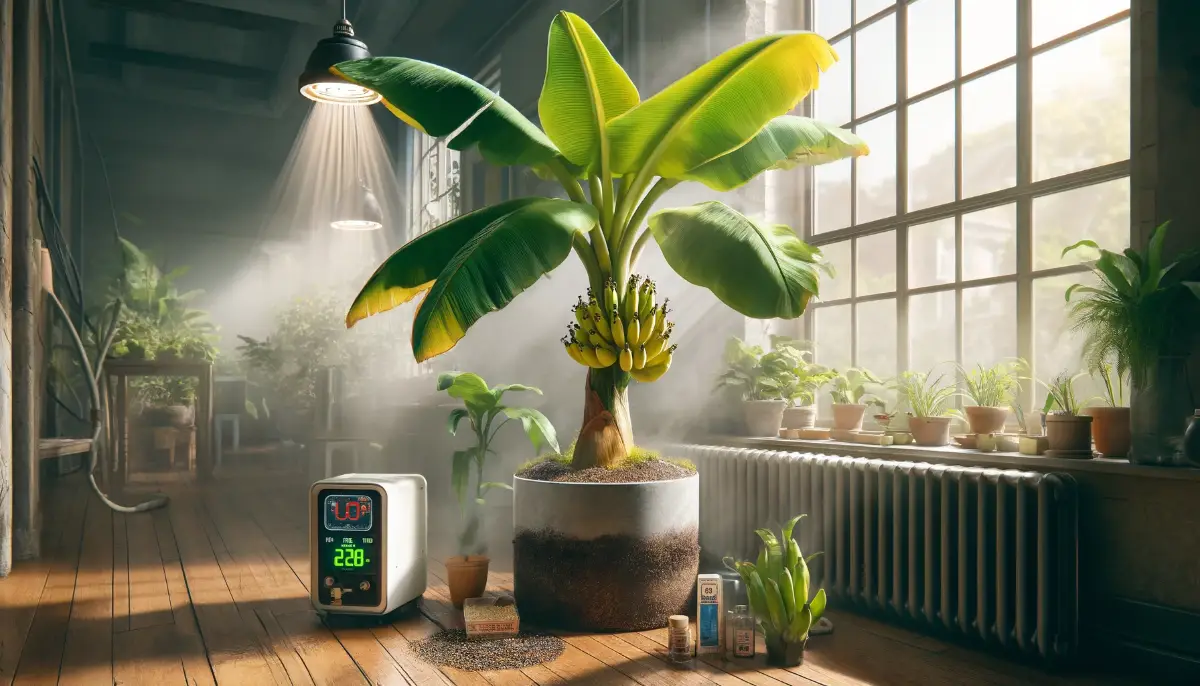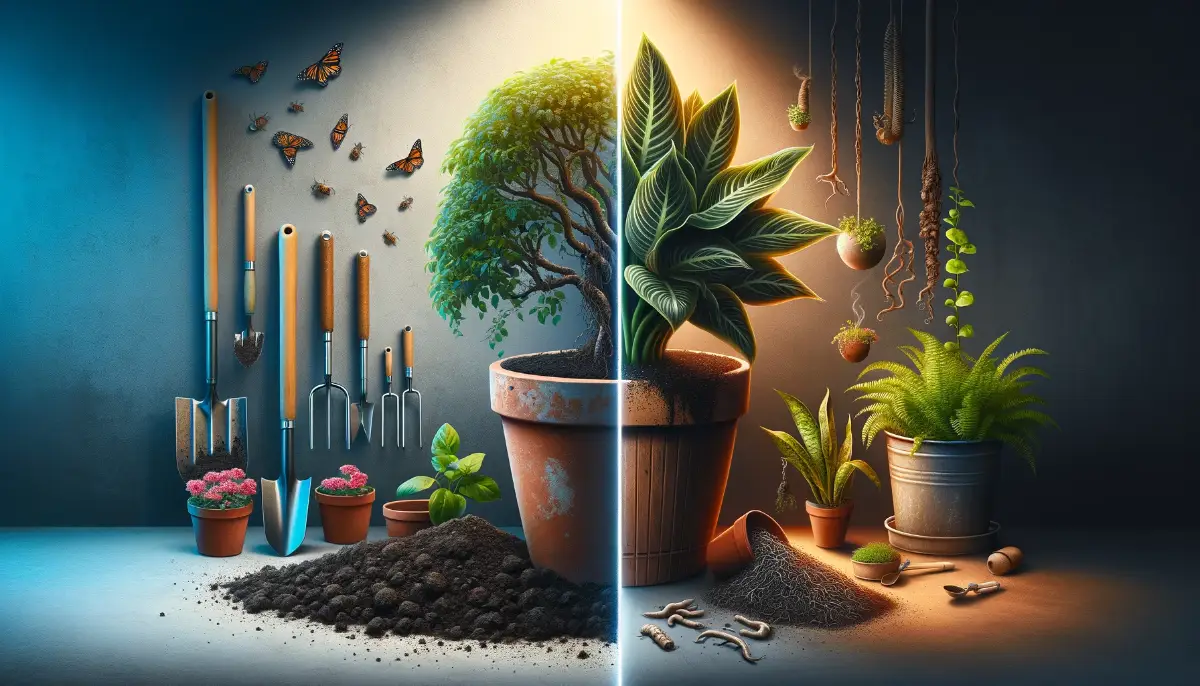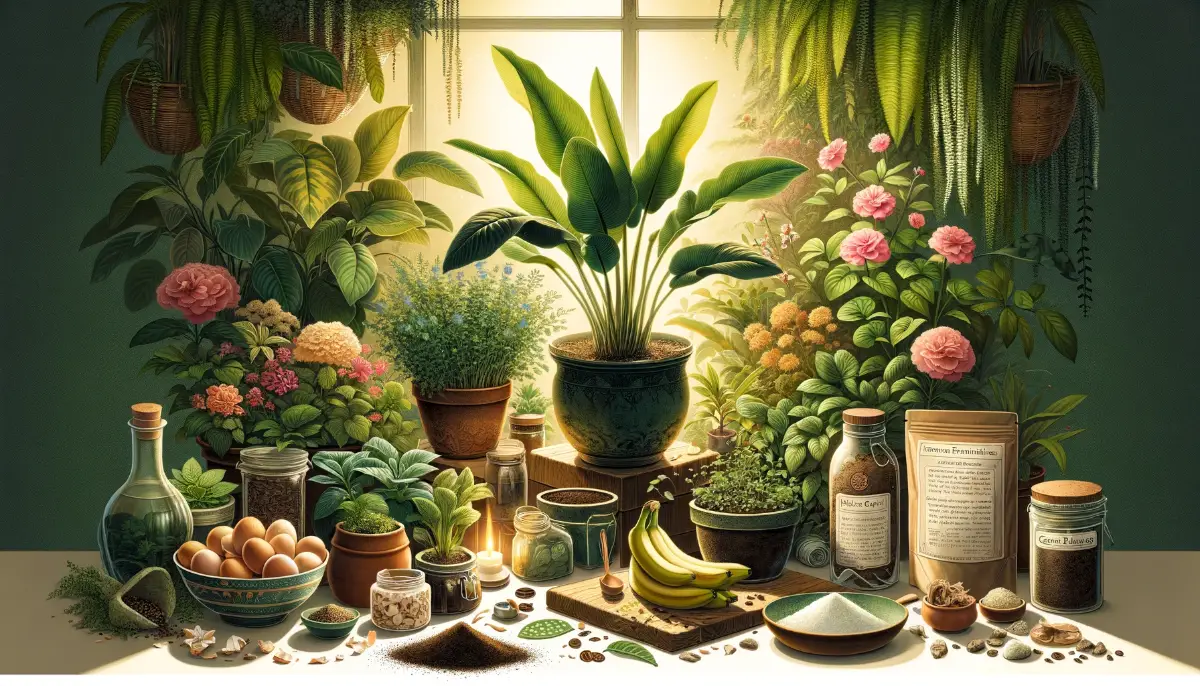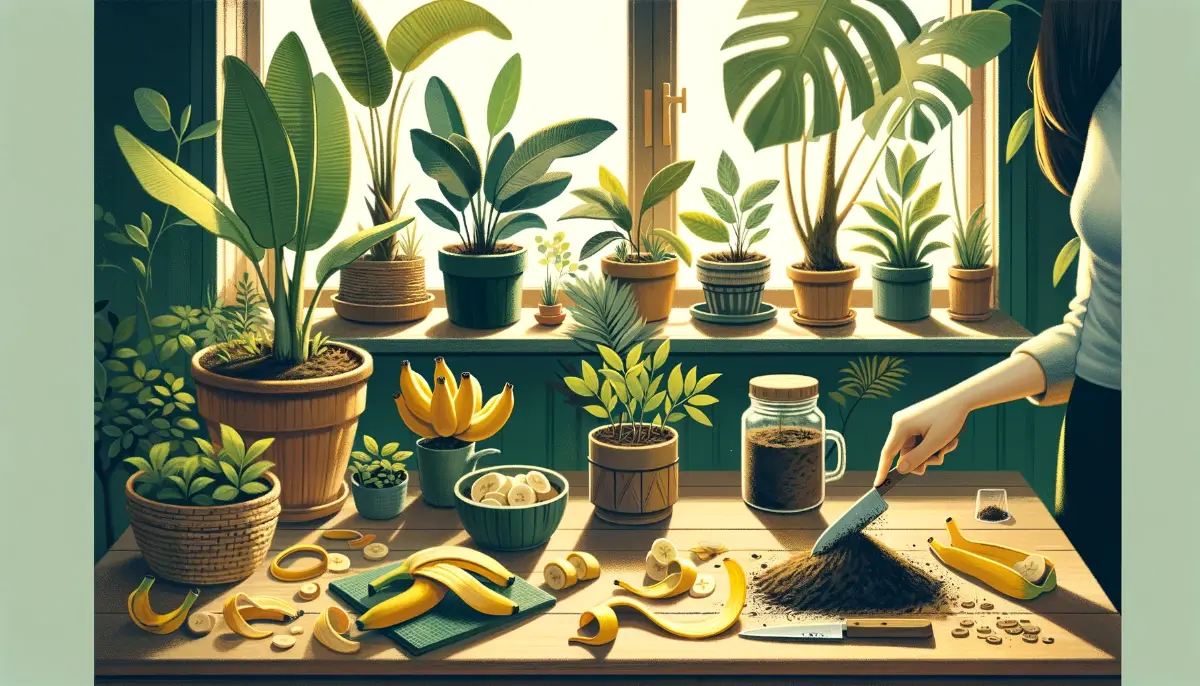Growing and caring for organic indoor banana trees is a rewarding endeavor that brings a touch of the tropics into your home. With the right conditions and care, you can nurture these lush, leafy plants to thrive indoors. Here’s everything you need to know to get started on this green journey.
Organic indoor banana trees are not just ornamental, they can also produce fruit under the right conditions. Dwarf varieties are particularly suited to indoor environments, offering manageable sizes and the potential for fruit production.
Whether you’re an experienced gardener or a novice looking to add some greenery to your living space, banana trees make a fantastic choice.
- Dwarf varieties are ideal for indoor cultivation.
- Ensure your pot has ample drainage to prevent root rot.
- Banana trees require lots of sunlight, warmth, and humidity to thrive.
- Regular fertilization is key to supporting their rapid growth and fruiting potential.
- Propagation through suckers allows you to grow new plants from the parent tree.
Getting Started with Your Indoor Banana Tree
Selecting the Right Variety for Indoor Growth
Not all banana trees are suited for the indoor garden. The Dwarf Cavendish is often recommended due to its manageable size and adaptability to indoor conditions. These varieties can thrive in the controlled environments of our homes, provided they receive adequate care tailored to their tropical nature.
The Ideal Planting Setup
Choosing the right pot and soil is the first step to ensuring your banana tree’s healthy growth. A pot with sufficient drainage holes and room for root growth, filled with a well-drained, organically rich soil mix, sets the foundation for a thriving tree. Soil pH should ideally be between 5.6 and 6.5, mirroring the natural, nutrient-rich environment these plants love.
Sunlight and Temperature Requirements
Your indoor banana tree craves bright, direct sunlight for 6-12 hours a day and thrives in temperatures that mimic its native tropical climate. Although indoor environments can control temperature easily, ensuring enough sunlight may require strategic placement or the use of grow lights.
Watering Your Indoor Banana Tree
The tropical nature of banana trees means they prefer their soil to be consistently moist but not waterlogged. Finding the balance in watering is crucial to prevent issues like root rot. The soil’s top inch should dry out between waterings to signal it’s time for another drink.
Fertilization Strategies for Your Organic Indoor Banana Tree
Fertilizing your indoor banana tree is crucial for its growth, health, and productivity. Being heavy feeders, banana trees benefit greatly from regular and appropriate fertilization. However, using organic methods requires understanding both the nutrient needs of your banana tree and the sources of those nutrients.
Understanding Banana Tree Nutritional Needs
Banana trees require a balanced diet of nitrogen (N), phosphorus (P), and potassium (K), often referred to as the NPK ratio. These elements support leaf growth, root development, and fruit production, respectively. For organic indoor banana trees, finding natural sources of these nutrients is key.
Organic Fertilizer Options
- Composted Manure: A well-composted manure (chicken, cow, or horse) is an excellent source of nitrogen and other nutrients. Ensure it is well-aged to avoid burning the plant.
- Bone Meal: Rich in phosphorus, bone meal supports root development in banana trees. It’s slow-releasing, ensuring a long-term supply of phosphorus.
- Potassium: Green sand and composted banana peels are great sources of potassium, essential for fruit development. Potassium also helps in water regulation and disease resistance.
- Eggshells and Coffee Grounds: Crushed eggshells add calcium, while coffee grounds can contribute nitrogen and acidity to the soil, benefiting your banana tree’s overall health.
Fertilization Schedule
- During the growing season (spring to fall), fertilize your banana tree every 4-6 weeks. This helps support the active growth phase.
- In the winter, reduce fertilization frequency as the plant’s growth slows down.
Application Tips
- Always dilute liquid organic fertilizers according to the instructions to avoid nutrient burn.
- Apply solid organic fertilizers (e.g., compost, manure) around the base of the plant and gently incorporate them into the top layer of soil without disturbing the roots.
- Regularly check the plant’s response to fertilization. Yellowing leaves may indicate over-fertilization, while slow growth or pale leaves suggest a need for more nutrients.
Monitoring Soil Health
Healthy soil is the foundation of successful organic gardening. Regularly test your soil to ensure it has the right pH (5.5 to 6.5 for banana trees) and nutrient levels. Adjust your fertilization strategy based on soil test results to maintain optimal growing conditions.
Pruning of Your Indoor Banana Tree
Pruning and maintaining your indoor banana tree are essential practices to ensure its health, encourage growth, and possibly even fruit production. Understanding when and how to prune, as well as how to maintain your plant, can make a significant difference in its development.
Pruning Your Indoor Banana Tree
Pruning helps your banana tree direct its energy to the most productive parts, encouraging healthy growth and fruiting.
Remove Dead or Damaged Leaves: Regularly inspect your banana tree for any leaves that are yellowing, damaged, or dead. These should be carefully removed to prevent any disease from spreading and to allow for new growth. Using a clean, sharp pair of scissors or pruning shears, cut the leaf where it meets the stem.
Prune After Fruiting: If your indoor banana tree is mature enough to fruit, it will die back after fruiting. Prune the main stem down to the ground after harvesting the fruit, which encourages the growth of new shoots, known as “suckers” or “pups.” These pups can eventually grow into new fruiting plants.
Manage Suckers for Healthy Growth: Banana trees often produce several suckers, but not all should be kept as they can draw energy away from the main plant. Select one or two strong suckers to keep and remove the rest to focus the plant’s energy on fewer, healthier growths.
Propagating Indoor Banana Trees
Propagating indoor banana trees allows you to multiply your collection and continue enjoying the lush, tropical ambiance they bring to your home. Banana trees are typically propagated through division, specifically by separating suckers, also known as pups, from the mother plant.
Steps for Propagating Indoor Banana Trees
Select a Healthy Sucker: Choose a sucker that is vigorous and healthy. Ideally, it should have its own roots and be at least 3-4 feet tall to ensure it’s sufficiently mature to survive on its own.
Separate the Sucker: With a clean, sharp knife or garden saw, carefully cut the sucker away from the mother plant. Make sure to include some of the roots with the sucker. If possible, leave a small portion of the sucker attached to the main plant to help it heal more quickly.
Prepare the Sucker for Planting: Trim any excessively long roots to encourage new growth. You may also trim back some of the larger leaves to reduce water loss while the sucker establishes its new root system.
Potting the Sucker: Fill a suitable pot with a well-draining soil mix. Banana trees prefer a soil pH between 5.5 and 7. Plant the sucker in the pot, ensuring that the roots are well covered but the base of the stem is not buried too deeply. Water thoroughly after planting.
Aftercare: Place the newly potted sucker in a warm, bright location, but out of direct sunlight for the first few weeks to avoid stressing the plant. Keep the soil consistently moist but not waterlogged, and maintain a high humidity around the plant.
You may cover the plant with a plastic bag to create a mini-greenhouse effect, but ensure there’s enough air circulation to prevent mold growth.
Fertilization: Once the new plant shows signs of growth, start a regular fertilization regime with an organic, balanced fertilizer to support its development.
Tips for Success
- Timing: The best time to propagate banana trees is in the spring or early summer, giving the plant plenty of time to establish itself before the cooler months
- Choosing Suckers: Smaller suckers tend to establish more quickly than larger ones, but ensuring they have some roots is crucial for their survival.
- Patience: It may take several weeks or even months for the sucker to fully establish and begin active growth. Monitor its progress and adjust care as needed.
Propagating indoor banana trees can be a rewarding experience, allowing you to expand your indoor jungle. By following these steps and providing the right care, you’ll increase your chances of successful propagation and enjoy the growth of new banana plants in your home.
Pest and Disease Management
Common Pests
- Spider Mites: These tiny pests can cause the leaves to yellow and drop prematurely. Increasing humidity around the plant can deter them, as they thrive in dry conditions. Organic control includes washing the leaves with water or applying neem oil.
- Mealybugs: These pests appear as white, cottony masses on the leaves and stems, sucking the sap and weakening the plant. Control them by dabbing with a cotton swab dipped in rubbing alcohol or applying insecticidal soap.
- Fungus Gnats: Overwatering can lead to fungus gnat infestations. These pests thrive in moist soil and can damage young roots. Reduce watering and use diatomaceous earth on the soil surface as a preventive measure.
Common Diseases
- Root Rot: Caused by overwatering and poor drainage, root rot is a significant concern. Ensure proper drainage in pots and allow the top inch of soil to dry out between waterings. If detected, remove affected roots, repot in fresh soil, and reduce watering.
- Fungal Leaf Spot: Symptoms include brown spots on leaves which can lead to leaf drop. Improve air circulation around the plant, reduce leaf wetness, and remove affected leaves. Applying a fungicide may be necessary in severe cases.
Preventive Measures
Proper Watering: Avoid overwatering and ensure the pot has adequate drainage to prevent root diseases.
Good Hygiene: Regularly clean the leaves and the area around your plant to reduce pest attraction and disease spread.
Quarantine New Plants: Before introducing new plants to your indoor garden, quarantine them to ensure they’re not bringing in pests or diseases.
Inspect Regularly: Frequent inspection of your banana tree allows for early detection of pests or diseases, making control more manageable.
Organic Control Methods
- Neem Oil: An effective, organic option for controlling a wide range of pests and some fungal diseases. Apply according to the product instructions, usually diluted in water.
- Insecticidal Soap: Use against soft-bodied insects like mealybugs and aphids. It’s safe for the plant and the environment when used as directed.
- Biological Controls: Introducing beneficial insects, such as ladybugs or predatory mites, can help control pest populations naturally without harming your banana tree.
Managing pests and diseases in your indoor banana tree organically requires attentiveness and care. By adopting these strategies, you can enjoy the benefits of organic indoor gardening, ensuring your banana tree grows healthy and strong.
Harvesting
Harvesting fruit from an indoor banana tree is a rewarding experience, marking the culmination of careful and attentive cultivation. Given the right conditions, an indoor banana tree can indeed produce fruit, although it requires patience and specific care to reach this stage.
Recognizing Harvest Time
Banana fruits grow in clusters known as “hands,” and recognizing when they are ready to harvest involves observing their appearance and feel:
Color Change: Bananas are ready to harvest when they start changing from deep green to lighter green, yellow, or even begin showing brown spots. The exact color at harvest can depend on the variety of banana.
Firmness: Ripe bananas will feel slightly soft under gentle pressure, indicating they are ready to be harvested.
Harvesting Process
Twisting or Cutting: Once the bananas are ripe, they can be harvested by carefully twisting the fruit off the stalk or using a clean, sharp knife to cut the stem. Avoid pulling the fruit directly as this can damage the plant and the fruit.
Harvesting in Bunches: It’s often easier to harvest the entire bunch at once, especially if the fruits ripen simultaneously. You can then hang the bunch in a cool, dry place to allow any unripe bananas to ripen gradually.
Post-Harvest Care
Ripening Off the Tree: If harvested while still slightly green, bananas can be left to ripen at room temperature. Placing them in a paper bag can accelerate the ripening process by trapping ethylene gas, which bananas naturally produce as they ripen.
Storage: Once ripe, bananas can be stored in the refrigerator to slow down further ripening. The skin may darken, but the fruit inside will remain fresh for a few days.
Plant Care After Fruiting
After fruiting, the main stem of the banana plant will die. However, the plant will likely have produced offshoots, or “pups,” which can be nurtured to grow into new fruit-bearing plants:
Remove the Dead Stem: Carefully cut down the dead stem, close to the base, to prevent any disease and to tidy up the plant.
Focus on the Pups: Select one or two vigorous pups to keep and grow on. These will become the next generation of your banana plant, potentially leading to more fruit in the future.
Harvesting bananas from an indoor tree is a testament to the grower’s dedication and care. While it can be a lengthy process, the satisfaction of enjoying home-grown bananas is unparalleled. Remember, success with indoor banana trees varies based on environmental conditions, care practices, and the variety of banana plant grown. Patience and attention to the plant’s needs throughout its growth cycle are key to achieving a fruitful harvest.
FAQs on Growing and Caring for Indoor Banana Trees
What’s the best variety of banana tree for indoor growth?
Dwarf varieties like Dwarf Cavendish are recommended for indoor cultivation due to their manageable size and suitability for indoor conditions.
How much light does my indoor banana tree need?
Indoor banana trees require 6-12 hours of direct sunlight per day. If natural light is insufficient, supplement with artificial grow lights.
How often should I water my indoor banana tree?
Water when the top inch of soil is dry, ensuring the plant is in well-draining soil to prevent root rot. The frequency will depend on the environmental conditions of your home.
What type of soil is best for an indoor banana tree?
Use a well-drained, organically rich potting mix with a pH between 5.6 and 6.5, similar to what you’d use for palm trees.
How do I fertilize an indoor banana tree, and how often?
Fertilize every 4-6 weeks during the growing season with a balanced, water-soluble fertilizer or organic alternatives like composted manure or a balanced NPK organic fertilizer.
Can indoor banana trees actually produce fruit?
Yes, with adequate light, warmth, and care, indoor banana trees can produce fruit, although it might take several years for the tree to mature enough to fruit.
How do I deal with pests on my indoor banana tree?
Use organic pest control methods such as neem oil or insecticidal soap to combat common pests like spider mites, mealybugs, and fungus gnats.
How do I propagate an indoor banana tree?
Propagate through division by separating suckers (pups) from the mother plant, ensuring each pup has some roots attached.
Why are the leaves of my indoor banana tree turning yellow?
Yellow leaves can be caused by overwatering, under-watering, or a lack of nutrients. Adjust your watering schedule and ensure you’re fertilizing regularly.
When and how should I prune my indoor banana tree?
Prune dead or damaged leaves regularly to maintain plant health. After fruiting, the main stem will die and should be cut back to allow pups to grow.











